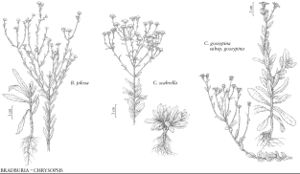Bradburia
Fl. N. Amer. 2: 250. 1842.
| Taxon | Illustrator ⠉ | |
|---|---|---|
 | Bradburia pilosa Chrysopsis scabrella Chrysopsis gossypina subsp. gossypina | Marjorie C. Leggitt Marjorie C. Leggitt Marjorie C. Leggitt |
Annuals, rarely perennials, 15–80 cm; caudices taprooted, woody. Stems erect, usually simple (annuals), sometimes proximally branched (perennials), sparsely pilose. Leaves basal and cauline; alternate; basal petiolate, cauline sesssile; blades 1-nerved, oblanceolate (bases attenuate), margins entire or apically dentate, sometimes coarsely hispido-pilose (apices acute), faces hispido-pilose, sometimes coarsely so; cauline blades linear-lanceolate to elliptic-oblong, reduced distally, obscurely apically dentate or entire, faces pilose. Heads radiate, borne singly or in lax paniculiform arrays (on long branches from distal nodes, much exceeding primary and higher level branches from which they arise). Peduncles 1.5–10 cm, short-hispido-pilose, stipitate-glandular distally. Involucres campanulate, (6–9 ×) 6–17 mm. Phyllaries 25–60 in 3–5 series, 1-nerved (midnerves yellowbrown to brown, somewhat translucent, faint to obvious, raised; outer somewhat keeled proximally), linear to linear-lanceolate, strongly unequal, scarious to herbaceous distally, margins broadly scarious, faces sparsely to densely short to long-pilose, sparsely glandular. Receptacles flat to slightly convex, pitted, epaleate. Ray-florets 7–25, pistillate, fertile; corollas yellow. Disc-florets 11–60, bisexual and fertile, or functionally staminate and sterile; corollas yellow, tubes shorter than cylindric, distally narrowly expanded throats, lobes 5, erect, triangular; style-branch appendages linear-triangular. Cypselae (straw to brown) obconic-obovoid, compressed or triangular, smooth or slightly ribbed, faces short-strigose; pappi persistent, of 20–35 stramineous to rusty brown, apically attenuate bristles in 2–3 series, outer either bristles grading into inner series or scales. x = 4, 3.
Distribution
se United States
Discussion
Species 2 (2 in the flora).
Bradburia was considered monotypic until recently. J. C. Semple and C. C. Chinnappa (1984) thought that one species, B. hirtella, was closely related to Chrysopsis pilosa but not to species of Heterotheca. G. L. Nesom (1991) included B. hirtella within Chrysopsis sect. Bradburia with C. pilosa. Semple (1996) maintained the genus as separate and transferred C. pilosa to Bradburia. In a cladistic study of subtribe Chrysopsidinae, Semple and L. Tebby (1999) found that the two species of Bradburia form a strongly supported group in a clade with Heterotheca and Croptilon, while Chrysopsis is in a clade with Pityopsis, the Mexican monotypic genus Tomentaurum G. L. Nesom, and the South American genus Noticastrum de Candolle.
Selected References
None.
Lower Taxa
Key
| 1 | Disc florets staminate; ray pappi of narrow, broad-based bristles 1–3 mm, outer series shorter than and grading into inner bristles | Bradburia hirtella |
| 1 | Disc florets bisexual; ray and disc pappi in 2 distinct series, outer of flat scales 0.5–1.1 mm, inner of barbellate bristles 5–6 mm | Bradburia pilosa |
"[" is not declared as a valid unit of measurement for this property."]" is not declared as a valid unit of measurement for this property.